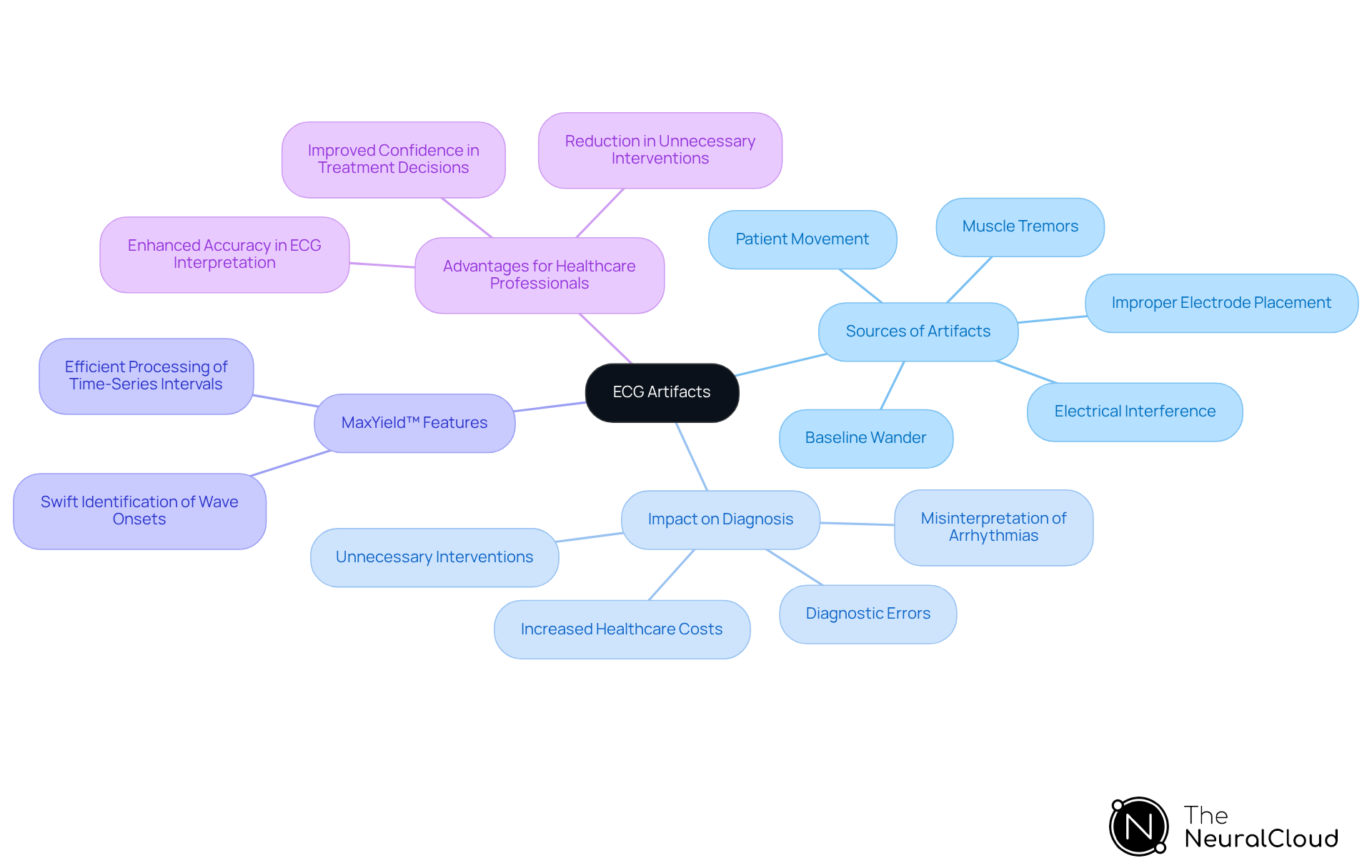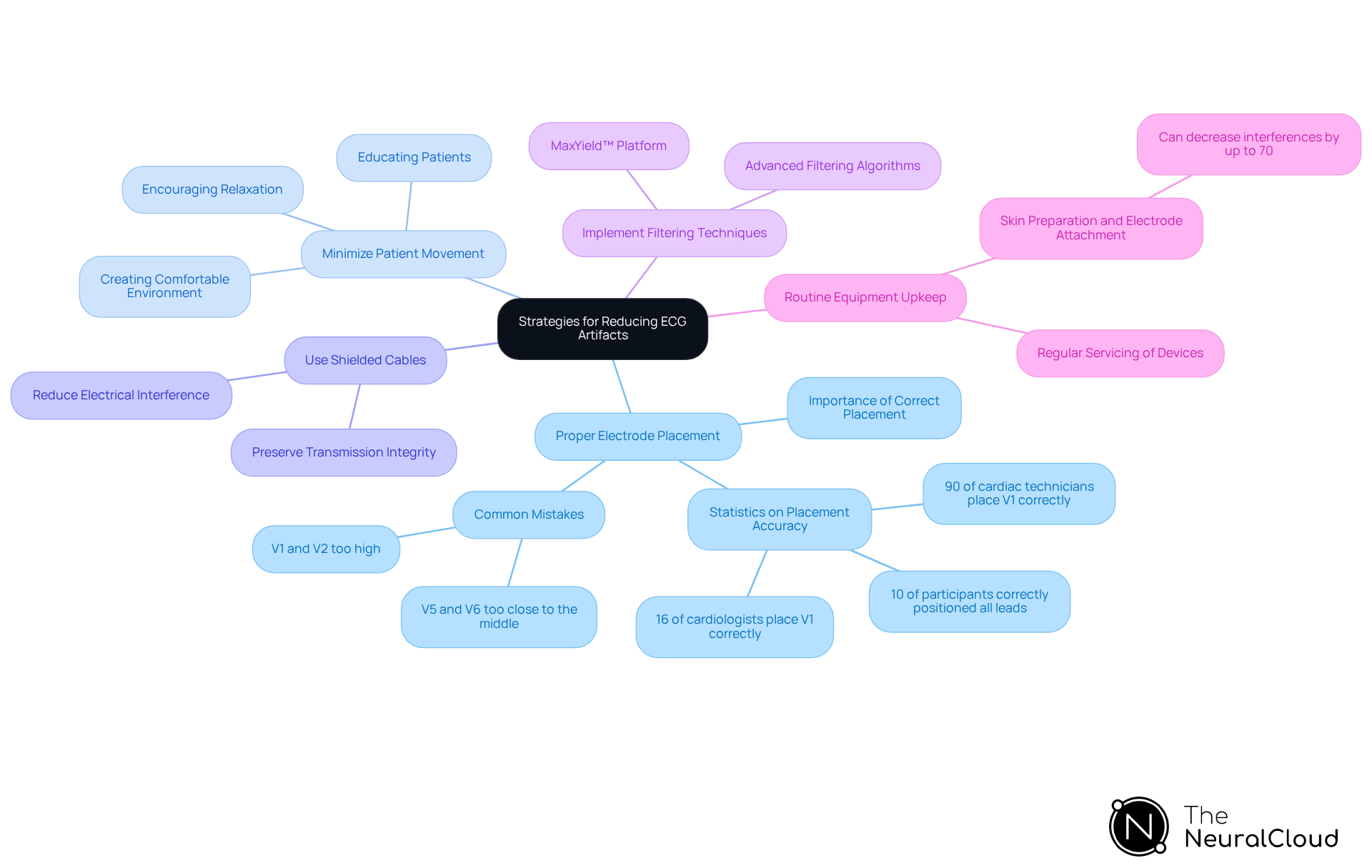Overview
ECG artifacts are interferences in electrocardiograms that do not originate from the heart's electrical activity. These artifacts can lead to misinterpretation and erroneous diagnoses, presenting significant challenges in ECG analysis. Recognizing these artifacts, such as motion distortions and electrical interference, is crucial for accurate readings. The MaxYield™ platform offers advanced technologies designed to enhance diagnostic accuracy and patient care by effectively identifying and mitigating these disturbances.
The MaxYield™ platform features sophisticated algorithms that analyze ECG data in real-time, allowing for the detection of artifacts that may otherwise go unnoticed. By improving the clarity of the ECG readings, healthcare professionals can make more informed decisions regarding patient care. This capability not only reduces the risk of misdiagnosis but also streamlines the workflow in clinical settings.
The advantages of utilizing the MaxYield™ platform extend beyond just improved accuracy. Healthcare providers benefit from enhanced efficiency, as the platform minimizes the time spent on artifact correction and enables quicker diagnosis. Furthermore, the integration of this technology into existing systems allows for seamless adoption, making it an invaluable tool for professionals in the field.
In summary, the MaxYield™ platform addresses the critical issue of ECG artifacts with innovative solutions that improve diagnostic processes. By prioritizing the identification and mitigation of these interferences, it ultimately supports better patient outcomes and enhances the overall quality of care.
Introduction
Understanding the nuances of electrocardiogram (ECG) artifacts is crucial for accurate cardiac monitoring and patient care. These artifacts—interferences that obscure the heart's electrical signals—can arise from various sources, such as patient movement and electrical noise. Such interferences can lead to misinterpretations that may compromise diagnoses and treatment plans.
As healthcare professionals navigate the complexities of ECG readings, they face the challenge of distinguishing genuine cardiac activity from these disruptive signals.
What strategies can be employed to enhance the clarity of ECG data and ensure reliable patient outcomes?
Define ECG Artifacts and Their Importance in Cardiac Monitoring
What are artifacts in ECG? They refer to the interferences that are disruptions in the electrocardiogram and do not originate from the heart's electrical activity. These disturbances can arise from various sources, including patient movement, electrical interference, and improper electrode placement. It is crucial to understand what are artifacts in ECG, as these interferences can lead to misinterpretation of the ECG, potentially resulting in erroneous diagnoses or treatment strategies. For instance, motion distortions can mimic arrhythmias, prompting healthcare providers to undertake unnecessary interventions. Research indicates that 38% of electrophysiologists misidentified irregularities as ventricular tachycardia, underscoring the essential need for precise recognition of these disturbances.
In clinical practice, it is paramount to understand what are artifacts in ECG to distinguish between genuine cardiac signals and distortions. This understanding not only but also fosters confidence in the treatment decisions made based on ECG data. The impact of ECG disturbances on patient outcomes can be significant; misinterpretations may lead to inappropriate medication use and unwarranted procedures, ultimately affecting patient care and healthcare costs. For example, proper electrode positioning and skin preparation can reduce ECG interferences by as much as 70%, providing valuable guidance for healthcare practitioners.
Furthermore, the integration of advanced algorithms, such as those utilized in Neural Cloud Solutions' MaxYield™ platform, significantly improves the quality of cardiac monitoring. MaxYield™ swiftly identifies P, QRS, and T Wave onsets, offsets, and time-series intervals, facilitating effective data processing and enhanced interpretation of results. By leveraging these innovative solutions, healthcare professionals can focus on high-level decision-making, ensuring that care for patients is both effective and efficient while addressing the challenges posed by physiological variability and signal disturbances.
Features of MaxYield™:
- Swift identification of P, QRS, and T Wave onsets and offsets.
- Efficient processing of time-series intervals.
Advantages for Healthcare Professionals:
- Enhanced accuracy in ECG interpretation.
- Improved confidence in treatment decisions.
- Reduction in unnecessary interventions and healthcare costs.
In conclusion, the MaxYield™ platform not only addresses the challenges of ECG analysis but also empowers healthcare providers to deliver superior patient care.

Explore Common Types of ECG Artifacts and Their Characteristics
Common types of ECG artifacts include:
- Motion Distortions: These distortions arise from patient movement, altering the baseline and waveforms, complicating precise ECG interpretation. They often manifest as irregular spikes or shifts in the baseline. Recent studies suggest that motion disruptions can significantly affect diagnostic precision, with misinterpretation rates reaching 14.3% among residents due to these disturbances. Moreover, the misunderstanding of ECGs caused by distortions has led to an astonishing 45% misdiagnosis rate with automated ECG systems, highlighting the essential requirement for awareness and mitigation strategies. MaxYield™ tackles this challenge by swiftly isolating ECG waves from recordings influenced by motion disturbances, improving the clarity of the data.
- Electrical Interference: This artifact originates from external electrical sources, such as nearby equipment or power lines, and can produce a consistent noise pattern on the ECG. For example, a 100 Hz background distortion from fluorescent lights can obscure genuine cardiac readings, potentially imitating conditions such as atrial fibrillation. Case studies have shown that minimizing electrical interference is essential for accurate readings, emphasizing the importance of proper equipment placement. MaxYield™'s advanced noise filtering capabilities help to mitigate these interferences, ensuring more reliable ECG interpretations.
- Poor Electrode Contact: Insufficient adhesion of electrodes to the skin can result in intermittent loss or noise, appearing as erratic waveforms or sudden drops in quality. Factors such as dry skin or excessive body hair can exacerbate this issue, highlighting the importance of proper skin preparation. Research shows that proper electrode positioning and skin preparation can decrease ECG disturbances by as much as 70%, greatly enhancing quality. MaxYield™ enhances this process by leveraging AI-driven automation for automated labeling, further reducing the potential for errors.
- Respiratory Artifacts: Breathing can introduce variations in the ECG signal, particularly in individuals with respiratory issues. These objects may seem like rhythmic variations that correlate with the respiratory cycle, complicating the interpretation of the ECG. The continuous learning model of MaxYield™ allows it to adapt and improve its accuracy in recognizing these patterns over time.
- Baseline Wander: Frequently induced by patient movement or alterations in electrode placement, this phenomenon leads to a gradual shift of the baseline. It can obscure critical ST-segment changes, making accurate diagnosis challenging. MaxYield™ effectively salvages previously obscured sections of lengthy Holter and patch monitor recordings, ensuring that healthcare professionals can make informed decisions based on clear data. Understanding what are artifacts in ECG and their features is crucial for healthcare professionals, enabling them to apply methods that and enhance diagnostic precision.

Implement Strategies for Reducing ECG Artifacts in Clinical Practice
To effectively , healthcare professionals should implement several strategies in clinical practice.
- Ensure Proper Electrode Placement: Following established guidelines for electrode positioning is essential for reducing poor contact and distortion. Studies indicate that proper placement can significantly enhance the accuracy of ECG readings. Research shows that only 10% of participants correctly positioned all leads. Regular training and adherence to protocols can improve placement accuracy; for instance, 90% of cardiac technicians successfully place V1 correctly, compared to only 16% of cardiologists.
- Minimize Patient Movement: Educating patients on the importance of remaining still during ECG recordings can greatly reduce motion artifacts. Providing a comfortable environment and clear instructions is key. Encouraging relaxation and proper limb support can mitigate involuntary movements that often lead to baseline fluctuations.
- Use Shielded Cables: Employing shielded ECG cables is essential for reducing electrical interference from external sources, especially in environments with multiple electronic devices. This practice preserves transmission integrity and clarity during recordings.
- Implement Filtering Techniques: Utilizing advanced filtering algorithms, such as those integrated into the MaxYield™ platform, can effectively isolate true cardiac data from noise. These algorithms automatically identify and reduce distortions, greatly enhancing clarity and diagnostic precision, thus boosting the overall effectiveness of ECG processes.
- Routine Equipment Upkeep: Ensuring that ECG devices and electrodes are consistently serviced and substituted as necessary is crucial for avoiding equipment-related problems that can cause distortions. Adequate skin preparation and electrode attachment can decrease interferences by up to 70%, improving overall signal quality.
By adopting these strategies, healthcare professionals can significantly enhance the quality of ECG recordings, which helps clarify what are artifacts in ECG, leading to more accurate diagnoses and improved patient care. It is important to note that common mistakes in electrode placement, such as V1 and V2 being placed too high, can lead to misinterpretation of ECG results. Misunderstandings attributed to discrepancies have been demonstrated to lead to a 14.3% misdiagnosis rate among residents and a 45% rate with automated ECG systems.

Leverage Advanced Technologies for Enhanced ECG Signal Clarity
To improve ECG clarity and reduce distortions, it is important to understand what are . Key innovations include:
- AI-Powered Algorithms: Platforms such as Neural Cloud Solutions' MaxYield™ leverage AI algorithms to automatically detect and classify ECG waveforms, significantly boosting the accuracy of readings. MaxYield™ effectively identifies and labels critical data, even in recordings with high noise levels, swiftly isolating ECG waves affected by baseline wander, movement, and muscle noise. These algorithms learn from extensive datasets, continuously refining their performance. The recent establishment of a national payment rate for AI-powered ECG analysis by CMS, effective January 1, 2025, highlights the growing institutional trust in these technologies.
- Real-Time Data Processing: Advanced ECG systems possess the capability to process data in real-time, which aids in the immediate identification and correction of what are artifacts in ECG. This feature is crucial in critical care environments where timely decisions are vital. As noted, CMS's initiative promotes early diagnosis, potentially reducing healthcare costs and improving outcomes for patients.
- Integration with Wearable Devices: The capacity to capture ECG data from various devices, including wearables, broadens access to cardiac monitoring. These devices often incorporate integrated algorithms to minimize noise and enhance transmission quality.
- Cloud-Based Solutions: Employing cloud technology for ECG data storage and analysis allows for scalable and efficient processing. This method enables healthcare providers to access high-quality ECG data from any location, promoting better collaboration and decision-making.
- Continuous Learning Models: Neural Cloud Solutions' MaxYield™ platform features continuous learning, adapting to new data and enhancing accuracy over time. This is particularly beneficial in addressing the variability of ECG readings across diverse populations, ensuring healthcare professionals can rely on precise data for informed decision-making. The platform's noise filtering, combined with P, QRS, and T Wave highlighting, streamlines workflows and automates repetitive tasks, processing more data in less time.
By harnessing these advanced technologies, healthcare professionals can significantly improve the clarity of ECG signals, leading to more reliable cardiac monitoring and enhanced patient outcomes.

Conclusion
Understanding ECG artifacts is essential for accurate cardiac monitoring and effective patient care. These interferences arise from various sources, including patient movement, electrical noise, and improper electrode placement, potentially leading to misinterpretations that may compromise patient outcomes. Recognizing the types of artifacts and their implications is crucial for healthcare professionals. This knowledge allows for the differentiation between genuine cardiac signals and distortions, ultimately enhancing diagnostic precision and treatment decisions.
The article outlines several key types of ECG artifacts, such as:
- Motion distortions
- Electrical interference
- Poor electrode contact
- Respiratory artifacts
- Baseline wander
Each artifact presents unique challenges that can significantly affect the accuracy of ECG readings. Strategies for mitigating these issues—like ensuring proper electrode placement, minimizing patient movement, using shielded cables, and leveraging advanced filtering techniques—are vital for improving the quality of ECG recordings. The integration of innovative technologies, such as Neural Cloud Solutions' MaxYield™ platform, further enhances the ability to accurately interpret ECG data, equipping healthcare providers with the necessary tools to deliver superior patient care.
In light of these insights, it is imperative for healthcare professionals to actively implement best practices for reducing ECG artifacts and to stay abreast of technological advancements in cardiac monitoring. By prioritizing accurate ECG interpretation and employing strategies to minimize interference, healthcare providers can significantly improve diagnostic outcomes and patient safety. The ongoing evolution of ECG technology presents an opportunity to enhance the reliability of cardiac assessments, ultimately leading to better healthcare outcomes and more informed clinical decisions.
Frequently Asked Questions
What are ECG artifacts?
ECG artifacts are interferences in the electrocardiogram that do not originate from the heart's electrical activity. They can arise from sources such as patient movement, electrical interference, and improper electrode placement.
Why is it important to understand ECG artifacts?
Understanding ECG artifacts is crucial because these interferences can lead to misinterpretation of the ECG, potentially resulting in erroneous diagnoses or treatment strategies, such as unnecessary interventions for conditions that are not actually present.
How common is the misidentification of ECG irregularities?
Research indicates that 38% of electrophysiologists misidentified irregularities as ventricular tachycardia, highlighting the need for precise recognition of ECG disturbances.
What impact do ECG disturbances have on patient outcomes?
ECG disturbances can significantly affect patient outcomes by leading to inappropriate medication use and unwarranted procedures, which ultimately impact patient care and healthcare costs.
How can proper electrode positioning and skin preparation affect ECG interferences?
Proper electrode positioning and skin preparation can reduce ECG interferences by as much as 70%, which is valuable guidance for healthcare practitioners.
What is the MaxYield™ platform and how does it improve cardiac monitoring?
The MaxYield™ platform integrates advanced algorithms to swiftly identify P, QRS, and T Wave onsets, offsets, and time-series intervals, facilitating effective data processing and enhanced interpretation of ECG results.
What are the advantages of using the MaxYield™ platform for healthcare professionals?
The advantages include enhanced accuracy in ECG interpretation, improved confidence in treatment decisions, and a reduction in unnecessary interventions and healthcare costs.
How does the MaxYield™ platform empower healthcare providers?
By addressing the challenges of ECG analysis and improving the quality of cardiac monitoring, the MaxYield™ platform empowers healthcare providers to deliver superior patient care while focusing on high-level decision-making.






